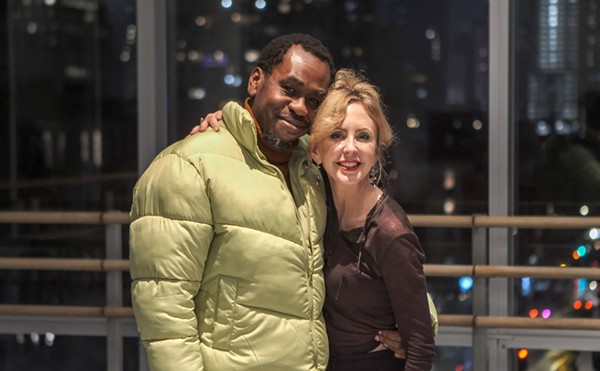Where can you go if you don't want to spend $12 for an art show? Two museums offer an alternative.
This summer it's going to be hard to go anywhere without being bombarded with an exotic theme: Chinese.
Art and artifacts, that is. There's the high-profile, high-priced spread that opened in May at Orlando Museum of Art, "Imperial Tombs of China." Its tariff is stiff -- $12 for adults, by reservation only -- and most of its 250 objects, from four major dynasties, are stern and monumental: gigantic stone statues of lions; an entire wooden carriage; embroidered robes of colorful silk; an empress's phoenix crown encrusted with pearls and precious gems; life-sized terra-cotta warriors and horses.
And then there is the cheap Chinese, spreads open to the public without admission fees but that otherwise are at least as valuable as "Imperial Tombs."
Two smaller exhibits -- "China: Exploring the Interior, 1903-1904" and "The Last Empress Dowager" -- went on view last month and remain at Maitland Art Center through Aug. 12. And another -- "Treasures of the Chinese Nobility" -- recently opened at Cornell Fine Arts Museum at Rollins College, where it will remain through September.
Each exhibit is worth seeing on its own. But together -- and especially in tandem with "Imperial Tombs" -- they amount to more than the sum of their parts. "Imperial Tombs," though impressive, is just that: important, awesome. The Maitland shows, by contrast, offer something crucial: They are personal, human in scale and firmly fixed -- all date from a narrow time frame, 1903-1905. And the Cornell's superb survey of a dozen dynasties, in elegant works dating from 3500 B.C.E. to 1912, tells the story of Chinese art history. "What's interesting about this show, unlike any other related to 'Imperial Tombs of China,' is that it's the only one that shows the same general area -- and more," says Cornell director Arthur Blumenthal.
"We're actually showing jade pieces, furniture, bronzes and many other works that were prized by members of the nobility during their lifetimes. Some came from tombs, but the emphasis is on what people actually used," he says. "Those few works had a double use -- they were treasured while their owners were alive, and then they were buried with them when they died."
In addition, while OMA's $2.5 million touring exhibit shows works made for tombs and excavated with great fanfare, the more than 140 pieces at the Cornell were acquired in the past year by Winter Park collector Chauncey P. Lowe. They show an individual's stamp, as do the 11 objects from Lowe's collection that make up the "Dowager Empress" exhibit at Maitland. That perspective gives "Treasures" an intimacy that's entirely lacking at the OMA installation.
Even more personal are the photographs and memorabilia in the Maitland Center's "Exploring the Interior" exhibit. From start to finish, the 49 prints made by the young American explorer and topographer R. Harvey Sargent on an 1,800-mile trek across the vast, uncharted interior of China, capture the spirit of a brief, long-varnished time. Along the way, hauling the heavy photographic equipment of the day, Sargent recorded the faces and places of rural China. These, it's clear immediately, are not people who wore the splendid robes and pendants that glow at Rollins; neither are they personages who had the clout that won them commemorative objects like those in OMA's stately, static display. Instead, they were gaunt, work-worn, often obviously impoverished. But they looked into Sargent's lens with lively interest, and sometimes with smiles.
The OMA show is powerful on its own. But seen in the context provided by the three related exhibits, each forceful in its own right, it becomes curiously focused on pomp, and not on the people who made or who "used" its objects, in life as well as through eternity.
Sidebar: An affection for antiques
Sit and talk with Chauncey Lowe in his Winter Park home, and it's easy to understand his role in the current exhibits at the Cornell Fine Arts Museum and Maitland Art Center. Especially "Treasures of the Chinese Nobility: The Chauncey P. Lowe Collection," at Cornell, which showcases more than 140 pieces and looks like an extension of Lowe's serene, high-ceilinged living room.
"I learned that the antiques are there for us to enjoy, that I'm just their caretaker," he says. "I like it here with them in the house, not in the sunshine as much as when it gets toward dark or when it rains. But I like to share them, too. The history appeals to me. Did you know that when the emperor and empress walked, jade chimes played, and that when they talked, music played? It was because he was the son of heaven -- the chimes thundered and clanged. I love that; I love knowing that the piece I hold was made when Cleopatra met Marc Antony, or when Moses led the Exodus."
Still, at home he is mildly apologetic. "It's empty in here now, just empty," he says, his voice a fine blend of feigned regret and pride. Somehow, it doesn't look empty. Many of the 600 or so pieces in the collections Lowe has amassed during the past 21 years -- 19 of them with his late companion, Dana Wolf, in whose memory the exhibits are offered -- are still here.
"I live with them all -- otherwise, why have it?" Lowe says, picking up a tiny golden animal sculpture and holding it up to his lapel. "Some-times I wear this as a pin."
Lowe, 46, whose roots are in Hawaii and, before that, in China, was born and raised in San Francisco. There, in keeping with his family's tradition, he became a pharmacist; actually, he smiles, that was a slight shift, since just about everyone else became a physician or a dentist.
As a child, he often visited a wonderland for a future collector: his grandparents' home in Honolulu. There, over many decades, they had added to the antiques they brought with them when they emigrated to Hawaii to grow pineapples. "Their home was full of Chinese furniture," he recalls, seeing that home for a moment in his mind. "At that time, I didn't realize what it was -- it was like a flea market to me."
Then, in 1976, he met Wolf at a party in San Francisco, and the two found that they shared a taste for certain kinds of art. Lowe had never studied art, or thought about collecting it. But all that changed, and the collection that steadily grew began with an Old Master drawing; it now includes works from the Renaissance, ancient Greece and Rome, and 19th-century Europe and Japan, along with a superb selection of Pre-Columbian terracotta and gold sculptures.
Yet it's the Oriental works that most fascinate Lowe, he says. Those include a stone sculpture in his living room of a Buddha, dramatically uplit, and a gilded screen that covers much of the wall behind a striped sofa, just to the side of an ornate black lacquered Japanese priest's chair crafted during the 18th century.
"I try to make my home serene," he says. "In the past two years I've lost some people I love very much -- Dana two years ago, and my mother a year ago. My work" -- at a Veteran's Administration clinic -- " is very stressful, so after work I come home and do my research. ... I read; I study. I have all the latest catalogs, magazines, books."
Not that Lowe buys at auction, or from the dealers who contact him. He is part of a circle of connoisseurs who communicate with one another. One of them is his sister, who lives in Honolulu and sends packages of new pieces to him every month. Many of them are in the Cornell, their places in his home filled with other pieces. One that wasn't moved is the black-and-gold screen over the bed that dominates his bedroom.
"This is a 16th-century screen, of deer in a landscape. In China, for centuries, it was used as a partition in a home," he says, before glancing at a low-lit golden scroll of a radiant Buddha hanging on the stairway to an upstairs study. "Look at that -- doesn't it look as if it's a painting? Now, look more closely. It's a Buddhist sutra. The whole sutra -- look at the details. It's the prayer and the chanting of the sutra, in every part of the painting: the nose, the whiskers -- isn't it incredible?" Lowe turns the rheostat to shed more light on the scroll-like painting. Suddenly, it's easy to see the almost microscopic characters that make up the lines on the portrait. "It was painted in the 14th century -- with a brush of one hair. One hair."
This Buddha is Japanese, the one in the living room is Thai -- all the same Buddha, "but in different interpretations from one country to another," Lowe says. "It's like that in all religions, isn't it? When you get to the bottom of them all, they're all about loving your fellow man," he says, looking from his study corner to the garden beyond. "These antiques have become my world -- they really have. I escape into it; I work at the clinic, and then I come home to it."

















